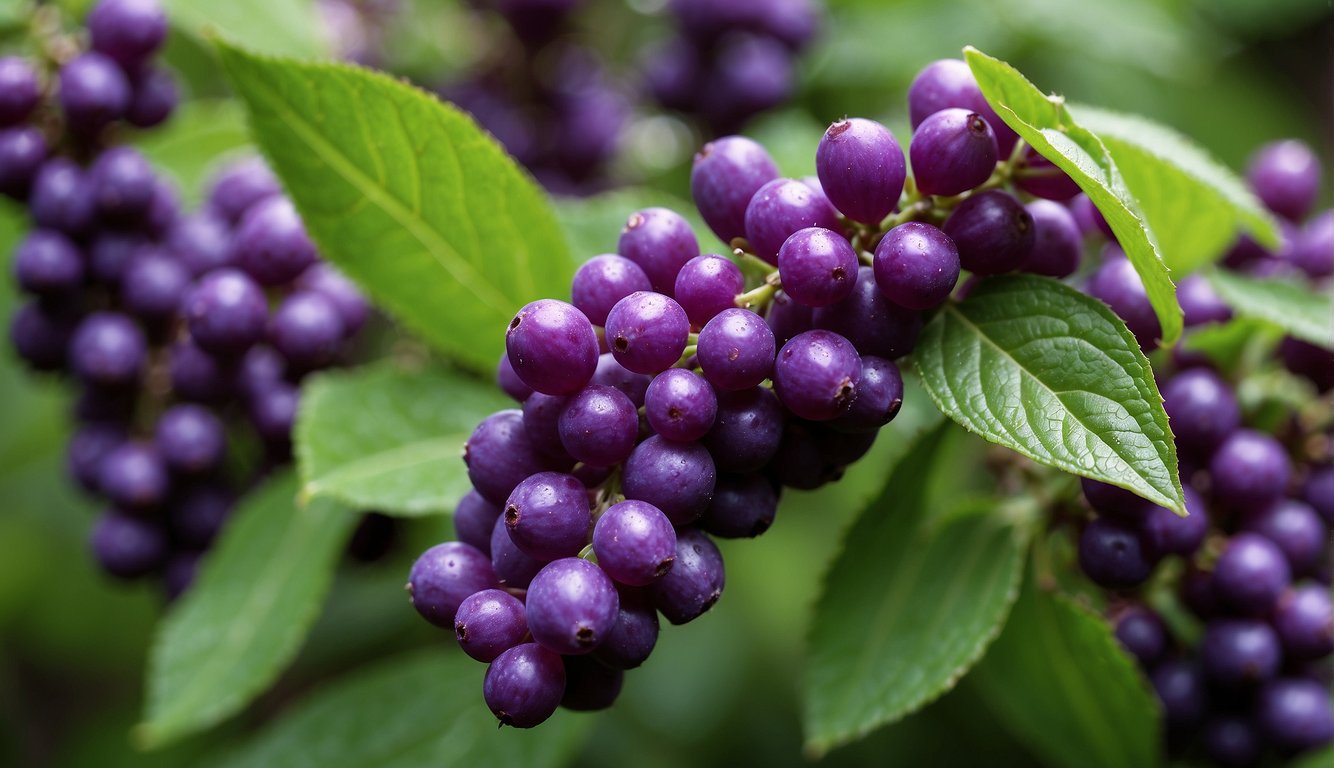TheHerbProf.com is a treasure trove of knowledge for those interested in natural healing and herbal remedies. The website is run by Paul Johnston MD. A naturopathic who has not only received extensive education in the field but also has personal experience in self-healing.
Can you eat Beautyberry? Beautyberry is a plant that is native to the Americas and is known for its bright purple berries. While it is often used for ornamental purposes, some people wonder if beautyberries are safe to eat. As someone who has researched this topic, I can confidently say that beautyberries are indeed edible, although they are not commonly consumed by humans.
The scientific name for the beautyberry is Callicarpa americana. This plant is primarily used for medicinal purposes and is known for its anti-inflammatory and antiviral properties. However, the berries are also edible and can be used to make jams, jellies, and juices. Despite their bitter taste, beautyberries are considered safe for human consumption in small quantities.
It is important to note that while beautyberries are edible, they are not commonly consumed by humans. This is because there are many other fruits and vegetables that are more palatable and nutritious. However, if you are interested in trying beautyberries, it is important to properly identify the plant and ensure that it has not been treated with any harmful chemicals.
What Is Beautyberry?
Beautyberry, also known as Callicarpa, is a genus of shrubs and small trees that are native to the southeastern United States, including Florida. One of the most popular species of beautyberry is Callicarpa americana, commonly referred to as the American beautyberry.
Botanical Profile
Beautyberry is a deciduous shrub that can grow up to 6 feet tall and wide. It has long, arching branches that are covered in bright green leaves. In the fall, the shrub produces clusters of bright purple berries that are about the size of a pea. The berries are tightly packed together and encircle the stem, creating a striking visual display.
Habitat and Range – Can You Eat Beautyberry?
Beautyberry is commonly found in the southeastern United States, particularly in the understory of forests and wooded areas. It prefers moist, well-drained soils and partial shade.
Ornamental Use
Beautyberry is a popular ornamental plant in gardens and landscapes. Its striking purple berries add a pop of color to fall landscapes. The shrub’s arching branches and bright green leaves also make it an attractive addition to any garden.
Overall, beautyberry is a beautiful and versatile plant that is well-suited for use in gardens and landscapes. Its striking purple berries are not only ornamental, but also have potential medicinal uses. However, it is important to note that while the berries are edible, they are not commonly consumed due to their astringent taste.
Cultivation and Care – Can You Eat Beautyberry?
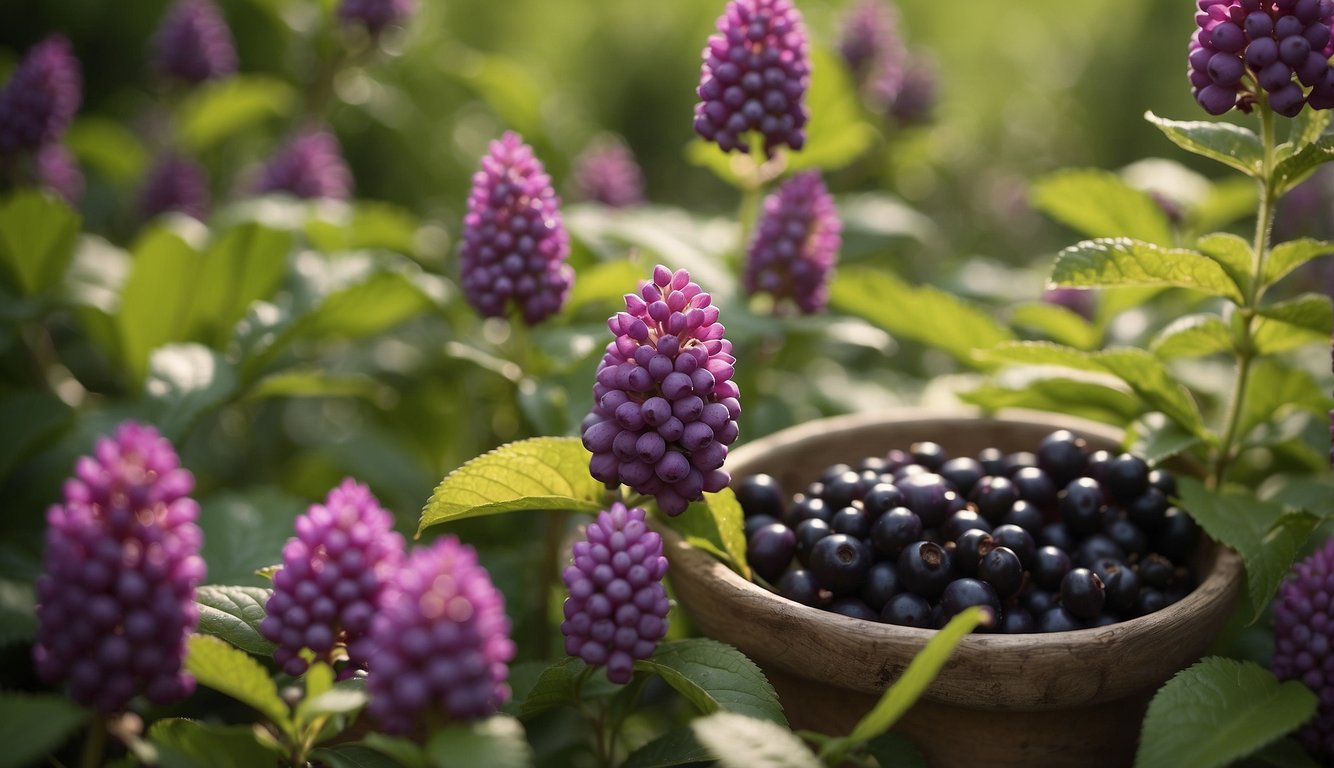
Planting Guidelines
If you’re interested in growing beautyberry, there are a few things you should know. First, beautyberry is a shrub that can grow up to 6 feet tall and wide, so make sure you have enough space for it. When planting beautyberry, make sure to space the shrubs at least 4 to 6 feet apart to allow for proper air circulation. You can either grow beautyberry from seeds or from cuttings.
Soil and Water Requirements
Beautyberry grows best in well-drained soil that is rich in organic matter. It can grow in a variety of soil types, including sand and loam, as long as the soil is well-drained. When planting beautyberry, make sure the soil is moist and well-drained. Beautyberry requires regular watering, especially during hot and dry weather.
Sunlight and Pruning – Can You Eat Beautyberry?
Beautyberry thrives in full sun to partial shade. It can grow in areas with as little as two hours of direct sunlight per day. If you want to encourage more berry production, plant the shrub in an area with more sunlight. Beautyberry requires very little pruning, but if you need to prune the shrub, do it in the late winter or early spring before new growth appears.
Propagation Methods
Beautyberry can be propagated from seeds or from softwood cuttings. If you’re propagating from seeds, make sure to plant them in a well-draining soil mix and keep them moist until they germinate. If you’re propagating from cuttings, take 4-6 inch softwood cuttings in the spring, strip the lower leaves, dip in rooting hormone, and plant in a moist mix.
Overall, beautyberry is a relatively easy shrub to grow and care for. With proper planting, soil, water, sunlight, and pruning, you can enjoy the beauty of the shrub in your garden.
Edibility and Nutritional Value – Can You Eat Beautyberry?
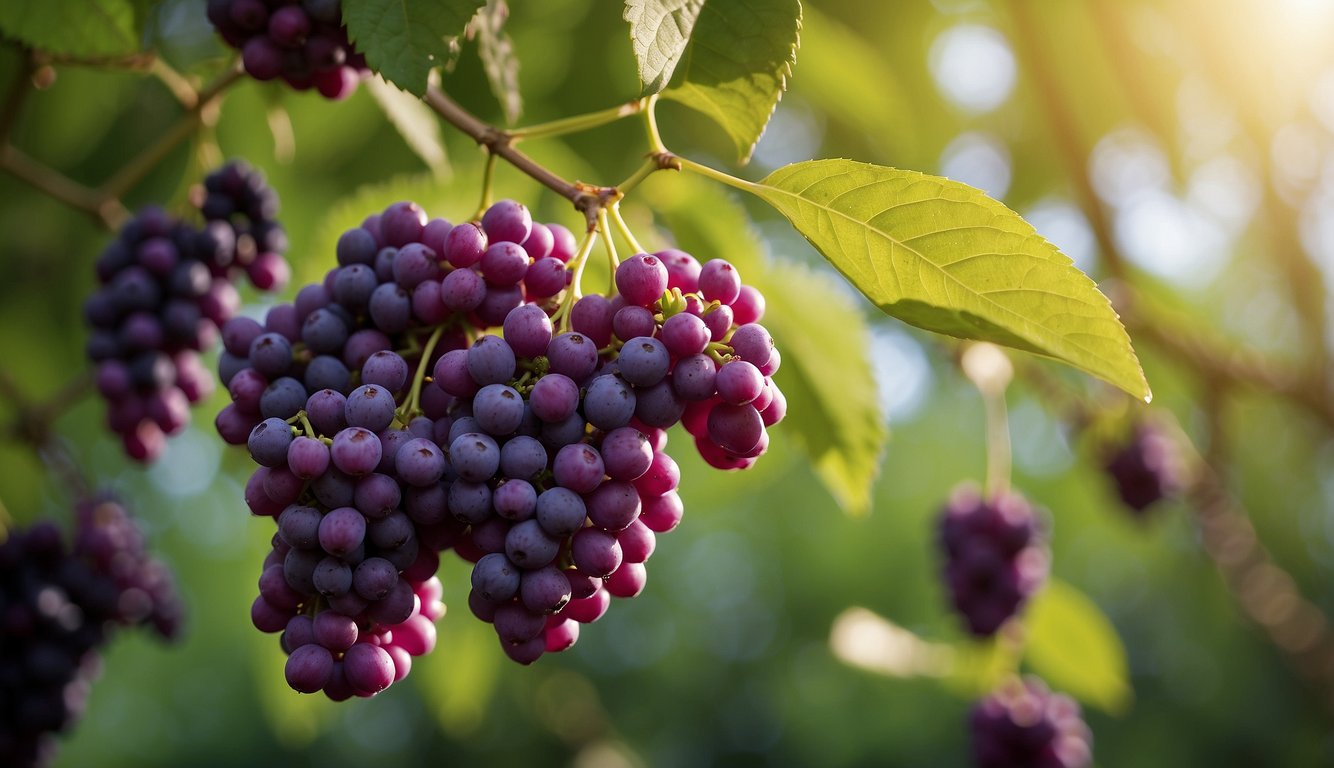
Safety for Human Consumption
As per my research, beautyberries are safe for human consumption in small quantities. The berries are edible for both humans and wildlife. However, the taste of the raw berries is often described as bland or mildly sweet, with a kind of medicinal aftertaste, and also kind of mealy in consistency. The berries are not the tastiest fruit and have an astringent flavor when consumed raw. Despite the taste, raw beautyberries are nutritionally beneficial and versatile in cooking.
Nutritional Components – Can You Eat Beautyberry?
Beautyberries are a good source of antioxidants and vitamins. They contain anthocyanins, which are a type of flavonoid that gives the berries their purple color. Anthocyanins have been shown to have anti-inflammatory and anti-cancer properties. They also contain vitamins A and C, calcium, and potassium. The leaves of the beautyberry plant are also edible and contain similar nutritional components.
Comparison to Other Berries
Beautyberries are not as well-known as other edible berries such as strawberries, blueberries, and blackberries. However, they are a great addition to any diet. They are worth foraging for and can be used in making jams, jellies, and juices. Adventurous eaters can find recipes for beautyberry jam online. Beautyberries are also used in traditional medicine for various ailments, such as fever and colic.
Beautyberries are an edible plant that is safe for human consumption in small quantities. They are not the tastiest fruit, but they are nutritionally beneficial and versatile in cooking. Beautyberries are a good source of antioxidants and vitamins, and they can be used in making jams, jellies, and juices.
Harvesting and Storage – Can You Eat Beautyberry?
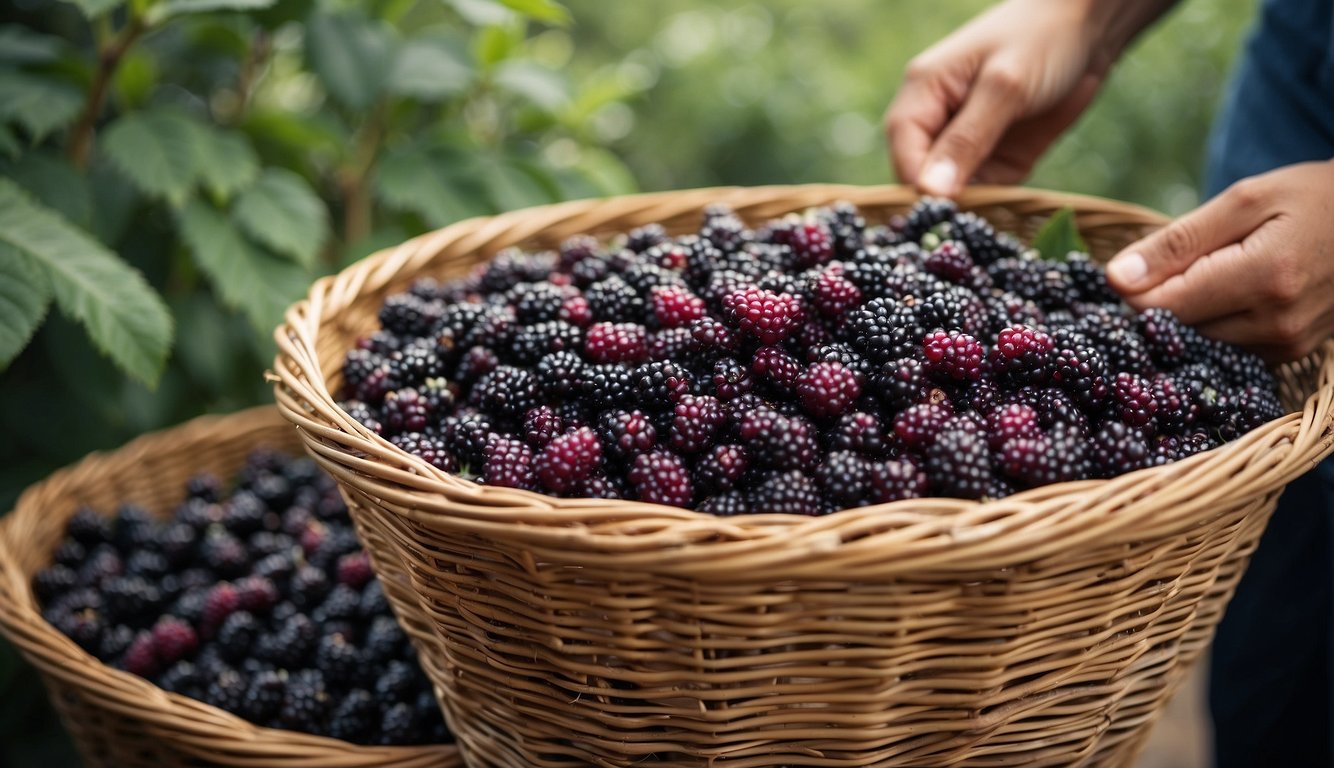
When it comes to harvesting and storing beautyberries, there are a few things to keep in mind to ensure that you get the best yield and preserve the quality of the berries.
When and How to Harvest
The best time to harvest beautyberries is when the berries turn a vibrant purple color, typically in late summer or early fall, after the American beautyberry flowers have bloomed. When harvesting beautyberries, it is best to pick the berry clusters gently from the bush to ensure that the berries don’t get crushed. Foragers typically search for the best fruit production in areas of partial shade, although the plant is adaptable and can prosper in full sun, provided that the soil remains adequately moist.
Post-Harvest Handling – Can You Eat Beautyberry?
Once the berries are harvested, they should be handled with care to avoid damaging the fruit. It is important to sort through the berries and remove any damaged or rotten ones. After sorting, rinse the berries with cool water to remove any debris or insects. Be sure to dry the berries thoroughly before storing them.
Long-Term Storage Techniques
Beautyberries can be stored in the refrigerator for up to two weeks, but they can also be frozen for long-term storage. To freeze the berries, simply spread them out on a baking sheet and place them in the freezer until they are frozen solid. Once frozen, transfer the berries to a freezer-safe container or bag and store them in the freezer for up to six months.
Harvesting and storing beautyberries is a simple process that can be done with just a few tools and some careful handling. By following these tips, you can ensure that you get the best yield and preserve the quality of the berries for later use.
Culinary Uses – Can You Eat Beautyberry?
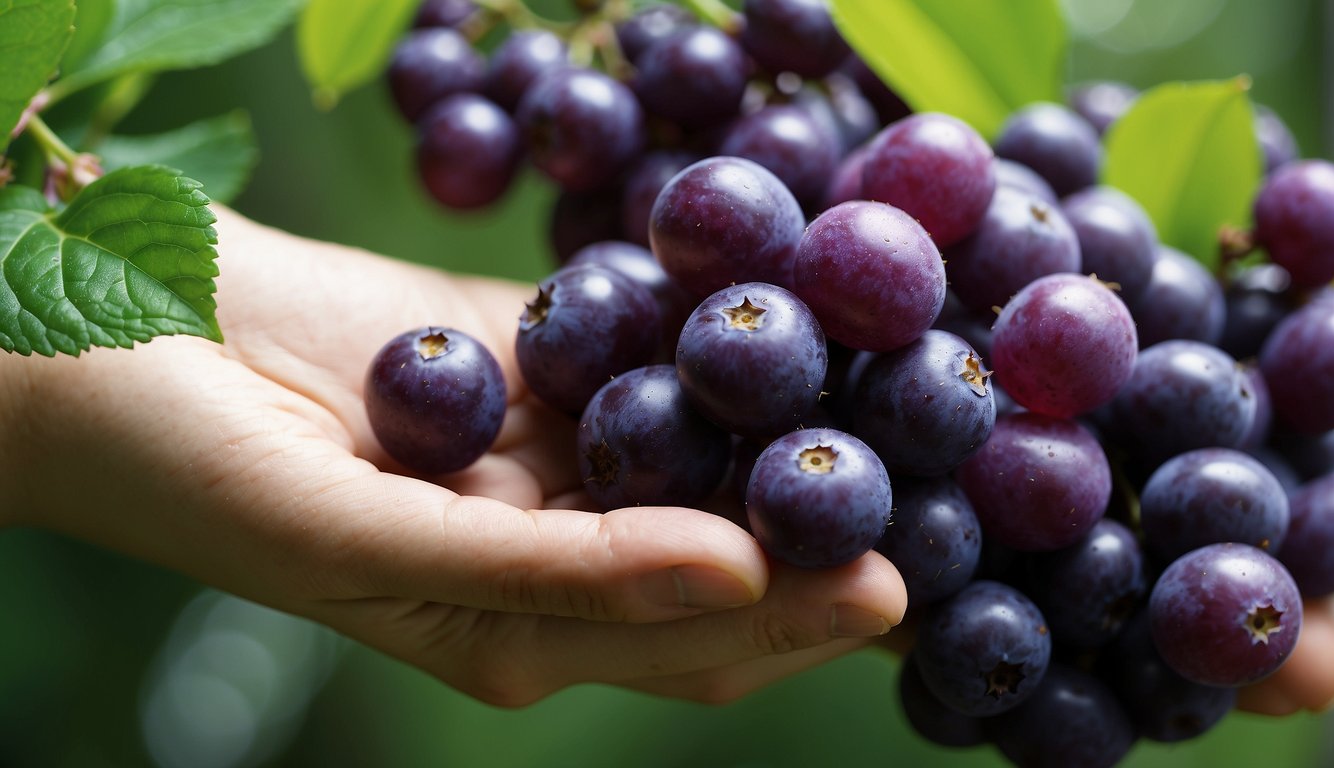
As an edible fruit, beautyberries have a unique, slightly astringent taste that can add a special touch to culinary creations. The berries can be enjoyed raw, but are more commonly used in making jams, jellies, and sauces. In this section, I will discuss some traditional and innovative culinary uses of beautyberries.
Traditional Recipes
One of the most popular ways to use beautyberries is by making beautyberry jelly. To make this delicious jelly, you will need to gather fresh beautyberries, sugar, pectin, and cheesecloth. After washing the berries, you will need to boil them in water and strain the juice through cheesecloth. Then, add sugar and pectin to the juice and boil it again until it reaches the desired consistency. Pour the jelly into jars and let it cool before serving.
Another traditional recipe is beautyberry pie. To make this pie, you will need to make a beautyberry filling by boiling the berries with sugar and cornstarch. Then, pour the filling into a pie crust and bake it until it is golden brown. This pie is perfect for those who love sweet and tangy desserts.
Innovative Culinary Creations – Can You Eat Beautyberry?
If you are feeling adventurous, you can try making beautyberry syrup or beautyberry tea. To make beautyberry syrup, you will need to boil the berries with sugar and water until the mixture thickens. Then, strain the syrup through cheesecloth and let it cool before serving. Beautyberry syrup can be used as a topping for pancakes, waffles, or ice cream.
To make beautyberry tea, you will need to boil the berries with water and strain the liquid through cheesecloth. Then, add honey or sugar to taste and serve the tea hot or cold. Beautyberry tea is a refreshing and healthy drink that can be enjoyed at any time of the day.
Preparing Beautyberry Tea
To prepare beautyberry tea, you will need to gather fresh beautyberries and wash them thoroughly. Then, boil the berries in water for 10-15 minutes and strain the liquid through cheesecloth. Add honey or sugar to taste and serve the tea hot or cold. Beautyberry tea can be enjoyed as is, or you can add other ingredients such as lemon, ginger, or mint to enhance the flavor.
Beautyberries are a versatile fruit that can be used in a variety of culinary creations. Whether you prefer traditional recipes or innovative culinary creations, beautyberries can add a unique and delicious flavor to any dish.
Other Uses and Benefits – Can You Eat Beautyberry?
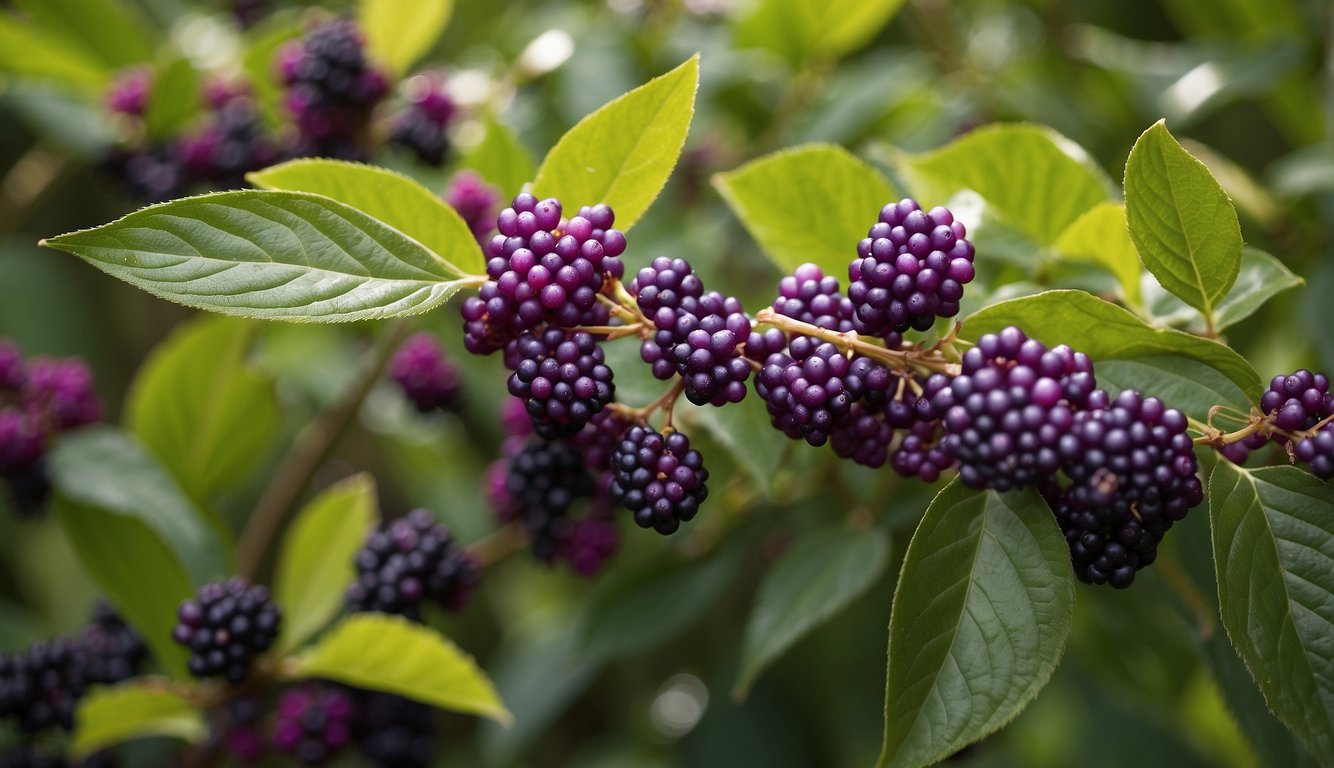
Natural Insect Repellent
Beautyberries have been traditionally used as a natural insect repellent. According to Tyrant Farms, the leaves of beautyberry plants contain a compound called callicarpenal, which has been found to repel mosquitoes, ticks, and ants. Callicarpenal is also known to repel other insects like butterflies.
Medicinal Properties – Can You Eat Beautyberry?
While there is no scientific evidence to support the medicinal properties of beautyberries, they have been used in traditional medicine for treating a variety of ailments. According to WhyFarmIt, beautyberries have been used to treat conditions such as fever, dysentery, and rheumatism. The leaves of beautyberry plants have also been used to treat skin conditions like eczema and dermatitis.
Wildlife and Ecological Significance
Beautyberries are established plants that require low-maintenance and are known to thrive in a variety of habitats. They are a crucial food source for birds and wildlife, especially during the fall and winter months when other food sources are scarce. According to Gardening Channel, the bright purple berries of the American beautyberry are edible for both humans and wildlife. Chickens have also been known to eat the berries. Beautyberry plants provide numerous ecological benefits, including erosion control and habitat restoration.
Can You Eat Beautyberry? Let’s Explore with TheHerbProf.com
Today, we’re diving into the world of Beautyberries. Ever wondered, “Can you eat Beautyberry?” Let’s find out together!
First up, Edibility. Yes, you can eat Beautyberries! They’re tart and a bit astringent, but totally edible. And guess what? TheHerbProf.com has a detailed guide on edible berries. It’s like having a personal berry consultant!
Next, the Uses. Beautyberries can be made into jellies, wines, and teas. And TheHerbProf.com? It’s got all the info you need to use your berries creatively. It’s a foodie’s dream!
Then there’s the Caution. Always make sure to identify your berries correctly before eating. And with TheHerbProf.com, you’ve got a guide to safe foraging. It’s like a DIY project for your garden! You can check our homepage here.
In short, eating Beautyberries and TheHerbProf.com are a match made in garden heaven. They offer a blend of practical foraging advice and fascinating plant facts. So, whether you’re a berry enthusiast or a curious visitor, there’s always something new to learn!
Remember, folks, nature’s pantry is full of surprises. Keep exploring TheHerbProf.com for more berry adventures!
References – Can You Eat Beautyberry?
Little Herb Encyclopedia, by Jack Ritchason; N.D., Woodland Publishing Incorporated, 1995
The Ultimate Healing System, Course Manual, Copyright 1985, Don Lepore
Planetary Herbology, Michael Tierra, C.A., N.D., Lotus Press, 1988
Handbook of Medicinal Herbs, by James A. Duke, Pub. CRP Second Edition 2007
The Complete Medicinal Herbal, by Penelope Ody, Published by Dorling Kindersley
Check the Following Articles!
Brussels Sprouts Seedlings: How to Grow & Care for Them
Can Broccoli Grow in Shade? Exploring the Possibilities
Bay Laurel Tree Care: Tips and Tricks for a Healthy Tree
Frequently Asked Questions – Can You Eat Beautyberry?
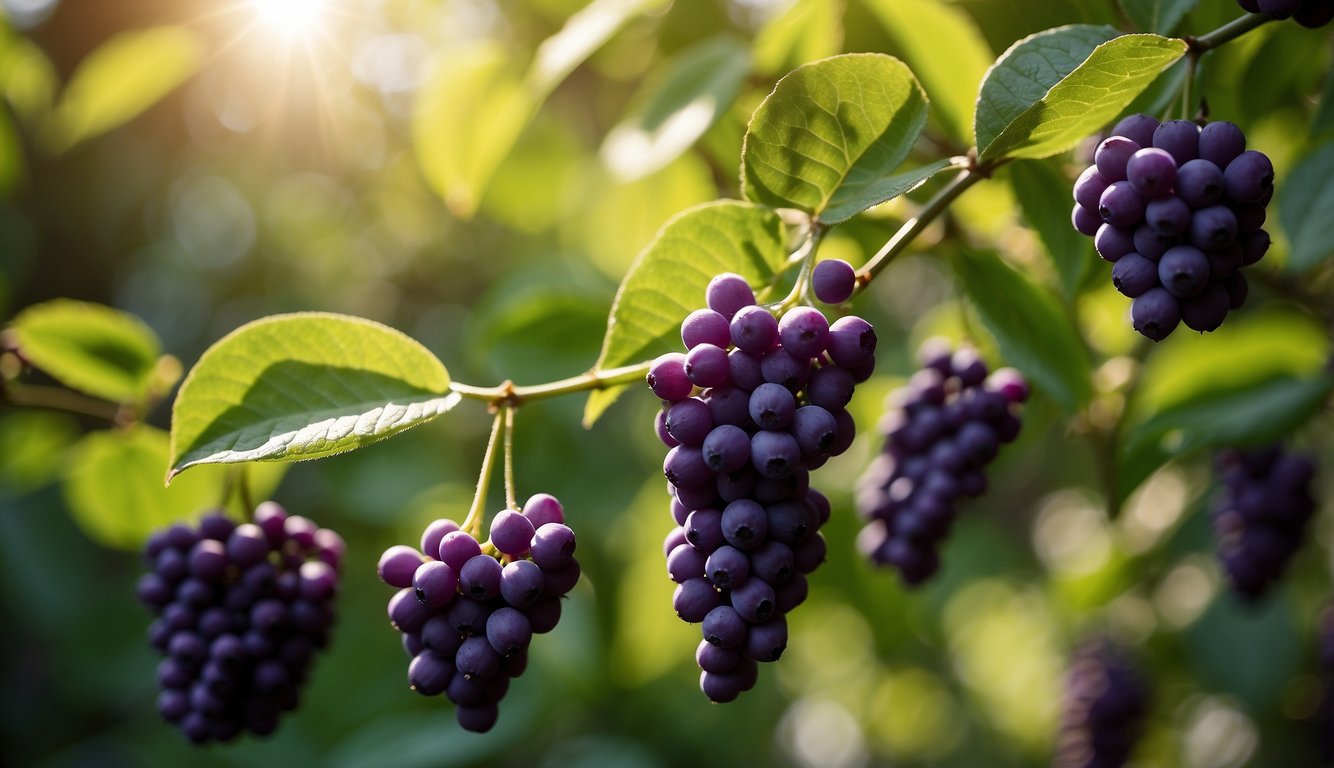
Are the seeds of beautyberries safe for consumption?
While the berries of beautyberry plants are safe for human consumption, the seeds of the fruit are not recommended for eating. The seeds contain cyanogenic glycosides, which can release cyanide when consumed in large amounts. Therefore, it is best to avoid eating the seeds of beautyberries.
Can beautyberries be consumed without cooking?
Beautyberries can be consumed without cooking, but they are typically consumed after being cooked or processed. Raw beautyberries have a tart taste and gritty texture, which makes them unpalatable for most people. However, cooking or processing the berries can help to bring out their natural sweetness and make them more enjoyable to eat.
What is the risk of toxicity in beautyberries to pets?
While beautyberries are safe for human consumption, they can be toxic to pets such as dogs and cats. Eating large amounts of beautyberries can cause gastrointestinal upset, including vomiting and diarrhea. Therefore, it is important to keep beautyberries and other potentially harmful plants out of reach of pets.
What are the medicinal properties of beautyberries?
Beautyberries have been used for centuries in traditional medicine to treat a variety of ailments. They are believed to have anti-inflammatory, antimicrobial, and antioxidant properties, and may be helpful in treating conditions such as fever, headache, and sore throat. However, more research is needed to fully understand the medicinal properties of beautyberries.
How does one identify and differentiate between beautyberries and their poisonous look-alikes?
Beautyberries are easy to identify by their bright purple berries, which grow in clusters along the branches of the plant. However, there are several poisonous plants that closely resemble beautyberries, including pokeweed and nightshade. To differentiate between these plants, it is important to pay attention to the size and shape of the leaves, as well as the color and shape of the berries.
What are the culinary uses of beautyberries, such as in jelly making?
Beautyberries are often used in culinary applications such as making jams, jellies, and juices. The berries have a unique flavor that adds a special touch to these culinary creations. Despite their astringent taste, raw beautyberries are nutritionally beneficial and versatile in cooking.
